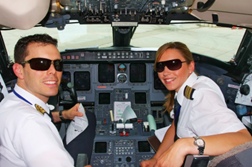
Now an analysis by USA Today of federal accident reports connected to the airline industry has found that more than half of the 522 US airline fatalities since 2000 have been linked to deficiencies with simulators.
In 2001 an American Airlines jet broke apart and 265 lives were lost. The NTSB determined that the cause of the November 12 accident was the pilot's aggressive use of the rudder, which resulted from the American Airlines' simulator, which provided a false sense of how the rudders worked.
A Boeing 737-500 jet skidded off a runway in Denver at high velocity during take-off and caught fire, severely injuring six passengers aboard the Continental Airlines flight. The NTSB determined in July that the December 2008 accident was caused in part by deficient simulator training.
After the Colgan Air crash in February of last year, in which a commuter plane practically dropped onto a home in a Buffalo suburb, the NTSB ruled that while simulators may not have directly led to the crash, improvements were needed to afford pilots better training and a more accurate sense of what to expect in the case of a similar emergency in the real world of flying.
READ MORE AIRPLANE CRASH LEGAL NEWS
The NTSB also found that airlines and their trainers were never informed as to the inaccuracy of their simulators.
An aviation safety consultant says that such a revelation is problematic. "It's really important to know how that data is programmed and where the holes are," said Kevin Darcy, formerly a chief accident inspector with Boeing, in comments to USA Today. "Otherwise you are fooling yourself."
The NTSB voted earlier this year to urge federal regulators to improve simulators, to the extent where they can properly instruct pilots on how to react in a real emergency.
